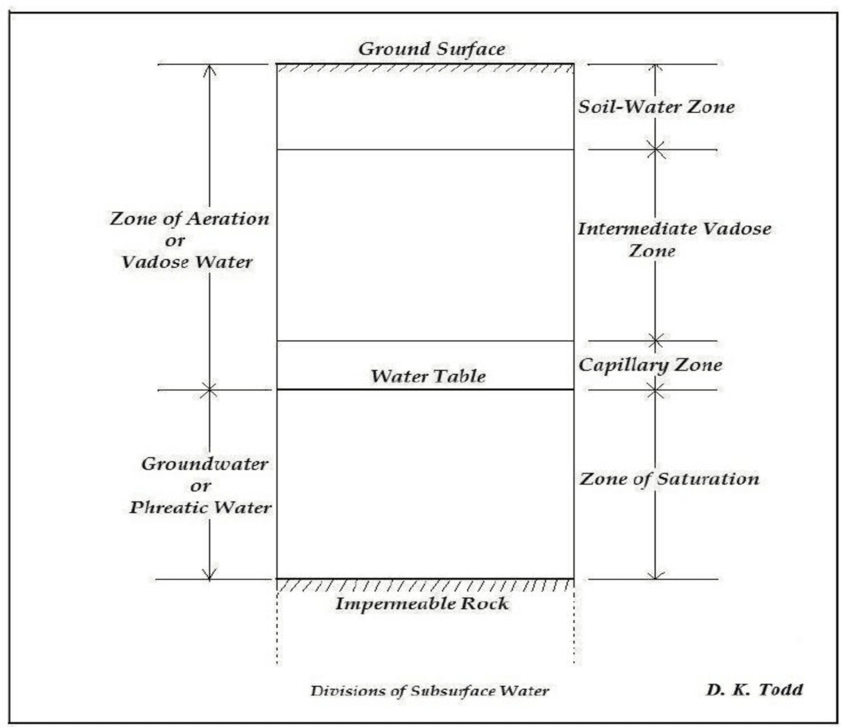Vertical distribution of groundwater:
The subsurface occurrence of groundwater may be divided into zones of aeration and saturation. The zone of aeration consists of interstices occupied partially by water and partially by air. In the zone of saturation all interstices are filled with water under hydrostatics pressure.

Zone of Aeration:
The zone of aeration subdivided into the soil water zone, the intermediate vadose zone and the capillary zone
Soil water zone:
Water in the soil water zone exists at less than saturation expect temporarily when excessive water reaches the ground surface as from rain fall or irrigation, The zone extends from the ground surface down through the major root zone. Its thickness varies with soil type and vegetation.
The amount of water present in the soil water zone depends primarily on the recent exposure of the soil moisture the soil water zone may contain water in excess of capillary water from rainfall or irrigation.
Intermediate vadose zone
The intermediate vadose zone extends from the lower edge of the soil water zone to the upper limit of capillary zone. The thickness may vary from zero, where the bounding zone merge with a high-water table approaching with a high water more than 100m under deep water table condition.
The zone serves primarily with that near the water table through which water moving vertically downward must pass. Non-moving vadose water is help in place by hygroscopic and capillary force.
Capillary zone
The capillary zone extends from the water table up to the limit of the capillary rise of water. If pore space could be idealized to represent a capillary tube, the capillary rise hc can be derived from an equilibrium between the surface tension of water and the weight of water raised. Thus
hc =2πcos λ/ry
Where π is surface tension, λ
is the angle of contact between the meniscus and wall of the tube.
Zone of saturation
In the zone of saturation, groundwater fills all of the interstices. The porosity provides a direct measure of the water contained per unit volume. A portion of the water can be removed from subsurface strata by drainage or by pumping of a well.
The thickness of the saturation zone varies from several meters beneath the earth’s surface to numerous hundred meters. The factors to determine the thickness of the zone depend upon the local geology, accessibility of opening or pores in the rock’s formation, and water flow within the zone from recharging to discharge points.
FAQs
What are the zones of subsurface groundwater occurrence?
Groundwater occurrence is divided into two main zones:
- Zone of Aeration: Interstices are partially filled with water and air.
- Zone of Saturation: All interstices are filled with water under hydrostatic pressure.
What is the Zone of Aeration?
The Zone of Aeration includes:
- Soil Water Zone: Extends from the ground surface through the major root zone.
- Intermediate Vadose Zone: Ranges from the lower edge of the soil water zone to the upper limit of the capillary zone.
- Capillary Zone: Stretches from the water table up to the limit of capillary rise.
What characterizes the Soil Water Zone?
The Soil Water Zone contains water less than saturation except during periods of excessive rainfall or irrigation. Its thickness varies based on soil type and vegetation.
How does water behave in the Soil Water Zone?
The amount of water depends on recent moisture exposure. This zone can contain water in excess due to capillary action from rainfall or irrigation.
What is the Intermediate Vadose Zone?
The Intermediate Vadose Zone extends from the soil water zone’s lower edge to the upper capillary zone. Its thickness can vary from zero to over 100 meters.
What role does the Intermediate Vadose Zone play?
It serves as a passage for water moving vertically downward towards the water table. Water is held in place by hygroscopic and capillary forces.
What is the Capillary Zone?
The Capillary Zone extends from the water table up to the limit of capillary rise. Capillary rise is determined by the equilibrium between surface tension and the weight of water.
How is the capillary rise (hc) calculated?
hc =2πcos λ/ry
- π\pi: Surface tension of water
- lambdaλ: Angle of contact between the meniscus and the tube wall
- r: Radius of the capillary tube
What is the Zone of Saturation?
The Zone of Saturation is where all interstices are filled with water. Its thickness varies based on geology, pore accessibility, and water flow from recharge to discharge points.
How does the Zone of Saturation function?
This zone contains groundwater, and its porosity measures water per unit volume. Water can be removed by drainage or well pumping.
